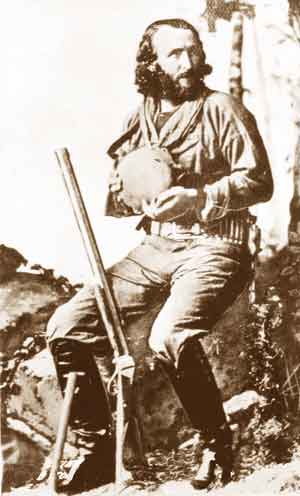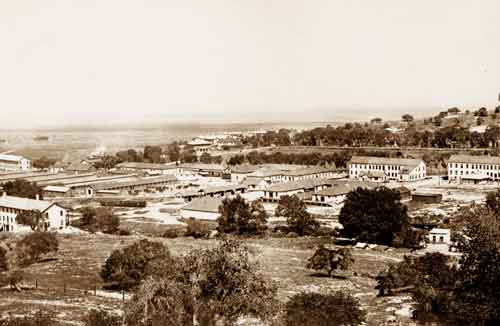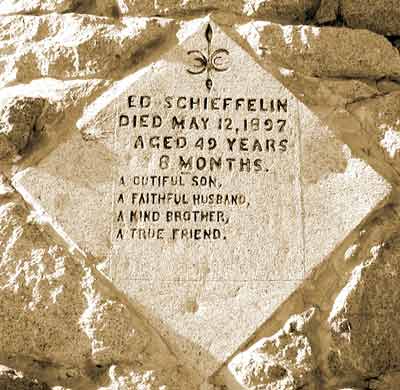
TOMBSTONE ARIZONA'S HISTORY & INFORMATION JOURNAL
TOMBSTONE ARIZONA'S HISTORY & INFORMATION JOURNAL
Thirty Cents and a Hunch
a story of Ed Schieffelin ~ Founder of Tombstone
by Janice
From the March 2003 issue of Tombstone Times
Thirty Cents and a Hunch
a story of Ed Schieffelin ~ Founder of Tombstone
by Janice
From the March 2003 issue of Tombstone Times
That is just how Ed Schieffelin started his quest for the riches soon to be found in the San Pedro Valley. Ed found places no white man had seen or even prospected before. He was venturing into an area known as Apache territory. Why just a dozen or so miles from his scouting locations was the Cochise Stronghold long known as the hideout for the band of Chiricahua Apache Indians lead by not only it's leader Cochise, but also Geronimo and Victorio.
The year was 1877 and Ed had been employed by the U.S. government as an Indian scout after leaving the Grand Canyon area and having found no riches there. He was headquartered at the nearby Camp Huachuca and often found himself not only performing his scouting duties but always on the lookout for his "big strike". It was common for Ed to wander off on his own in this dangerous territory and he would have had to proceed with care because the Indians were continuously active. There was little shelter from the elements much less places to hide, as the area was treeless. This required that Ed not stay in one place for more than one night. Consequently this made his search a slow progress and tedious work.
He searched the gullies and washes always looking for the proof of his hunch. His hunch that this area would be filled with the riches of silver for him to locate. He had not found any impressive looking ore, but he wouldn't let go. He couldn't let go. He kept on, working into more dangerous areas as he drew nearer to the Dragoon Mountains, hideout of the Apaches, and finally found some float ore, which looked good. Had this float or chunks of ore come from a deposit that had perhaps been washed away from the mother load miles away? Ed painstakingly traced this float to the ledge from which it came. He found the source. The source being a vein of silver. Riches, yes that is what Ed had found...riches of silver stone. Ed recalled what the soldiers at the camp had said when he was questioned about the "stones" he sought in the hills. Their reply to him was, "The only stone you will find out there is your tombstone". Ed Schieffelin had found his "Tombstone".
After many years of searching Ed was now just 29 years old and flat broke. How would he manage to not only stake his claim, but also venture into Tucson to have it assayed? He shared his vision with a man named William Griffith who promised to pay for the recording of anything Ed found in return for a claim of his own. Griffith was the man who actually recorded the Tombstone claim on September 3, 1877. However, Tucson did not have an assay office and the men to whom Griffith and Ed showed their ore to were of the belief that the sample was worthless. It was at this time that Griffith severed his connection with this venture going into ranching hoping for a better investment for his money. Ed now had to venture on without a backer. No matter what anyone else would have to say on this matter, Ed knew that silver was out there. He had a hunch.
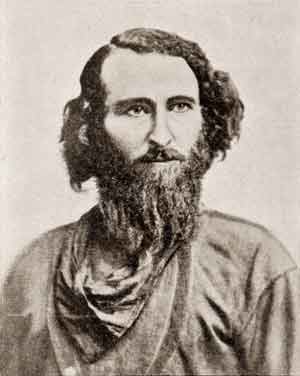 Ed Schieffelin has been described by James McClintock, an early historian, as "...about the queerest specimen of humanity ever seen in Tucson. His clothing was worn and covered with patches of deerskins, corduroy and flannel, and his old slouch hat too, was so pieced with rabbit skin that very little of the original felt remained. Although only 29 years of age he looked at least forty. His black hair hung down below his shoulders, and his full beard, a tangle of knots, was almost as long and he appeared to be a fur-bearing animal."
Ed Schieffelin has been described by James McClintock, an early historian, as "...about the queerest specimen of humanity ever seen in Tucson. His clothing was worn and covered with patches of deerskins, corduroy and flannel, and his old slouch hat too, was so pieced with rabbit skin that very little of the original felt remained. Although only 29 years of age he looked at least forty. His black hair hung down below his shoulders, and his full beard, a tangle of knots, was almost as long and he appeared to be a fur-bearing animal."
So this man of little wealth and being described as above made preparation to find help with his stake...but where? Well with only 30 cents in his pocket he decided to head to north to Globe Arizona to seek out his brother Al. However, Al was no longer at the Silver King Mine in Globe but had ventured on to the McCracken Mine in Signal City. Ed was flat broke at this time as he had spent his thirty cents on tobacco and found it necessary to work in a mine himself before he would be able to travel west to Signal City and meet up with his brother Al. He worked as a night operator of the hoist at a silver mine and hauled up a dozen tons of ore every night by cranking a hand windlass. This was back breaking work, but necessary to fund his search for his brother and perhaps his hunch.
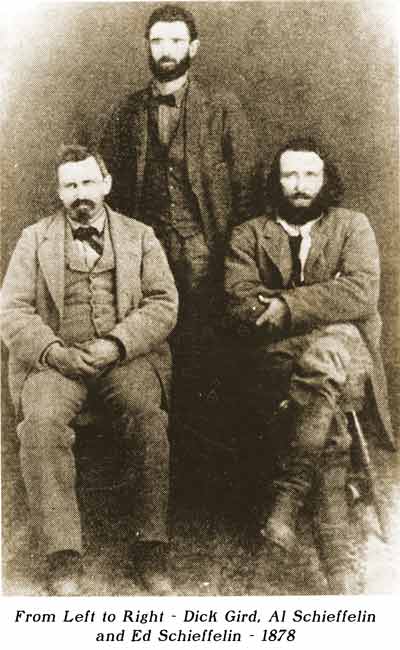 Having earned enough money he left for Signal City and finally found his brother. This is where Ed met up with Richard Gird. Gird was the assayer at the McCracken Mine and assayed the ore at $2,000 a ton!!! Was the hunch paying off? A partnership was slated and hands shook by the three and off to the hills of the Tombstone mine they went with Gird supplying a mule, a wagon, his assay equipment, his experience and connections to what would become known as the richest mining camp in the country.
Having earned enough money he left for Signal City and finally found his brother. This is where Ed met up with Richard Gird. Gird was the assayer at the McCracken Mine and assayed the ore at $2,000 a ton!!! Was the hunch paying off? A partnership was slated and hands shook by the three and off to the hills of the Tombstone mine they went with Gird supplying a mule, a wagon, his assay equipment, his experience and connections to what would become known as the richest mining camp in the country.
Mines sprung up along this area known as Goose Flats. Mines such as the "Lucky Cuss", "Tough Nut", and the "Contention" were soon to be assayed at around $15,000 to the ton. Ed Schieffelin had found the "mother lode" and Gird's investigations showed that the ore veins ran deep. Soon the area would be thronged with prospectors all wanting their share of the riches as word of the bonanza spread. There was now a need for a town. The town at Goose Flats, a mesa overlooking the Tough Nut claim was a superb location. A town site company was formed and in March of 1879 Solon M. Allis laid out the town. The town known today as Tombstone.
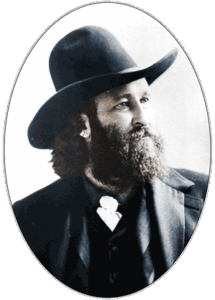 Ed Schieffelin was now a millionaire and wanted to set out and see the world. His journeys took him north not dressed as he was when he found his Tombstone, but in the finest of the day. He married Mary Brown whom he had met in San Francisco and settled in Los Angeles where they lived with his brother Al. Al died in 1885 of consumption. But later, longing for the solitude of the wilderness Ed left the riches and finery and headed for a cabin in Oregon to prospect again. A hunch perhaps. It was here in May of 1897 that Ed was found alone; his body slumped ever so peacefully across a worktable where samples of the gold ore were being worked. Ore that was eventually tested at more than $2,000 to the ton. But Ed Schieffelin did not leave behind a map or directions to his discovery. That would be up to others to locate. The last entry in his journal simply read, "Struck it rich again, by God."
Ed Schieffelin was now a millionaire and wanted to set out and see the world. His journeys took him north not dressed as he was when he found his Tombstone, but in the finest of the day. He married Mary Brown whom he had met in San Francisco and settled in Los Angeles where they lived with his brother Al. Al died in 1885 of consumption. But later, longing for the solitude of the wilderness Ed left the riches and finery and headed for a cabin in Oregon to prospect again. A hunch perhaps. It was here in May of 1897 that Ed was found alone; his body slumped ever so peacefully across a worktable where samples of the gold ore were being worked. Ore that was eventually tested at more than $2,000 to the ton. But Ed Schieffelin did not leave behind a map or directions to his discovery. That would be up to others to locate. The last entry in his journal simply read, "Struck it rich again, by God."
Ed had requested in his will that his burial site be where he found his Tombstone and that he be buried in prospector's clothing with his pick and canteen in the coffin with him. And so it is today that you will find the monument to our founder, Ed Schieffelin located near where he did prove his hunch true. A monument having been erected in his honor stating simply:
Ed Schieffelin
Died May 12, 1897
Aged 49 years 8 months
A dutiful son
A faithful husband
A kind brother
A true friend
Yes a hunch and a mere 30 cents was what Tombstone's founder Ed Schieffelin started out with. A hunch that ended up bringing the richest silver strike in the nation to this area and making him a wealthy man. Ed Schieffelin did find his "Tombstone" in the Apache Indian Territory of the Dragoon Mountains and as per his last request is still here and in our hearts.

